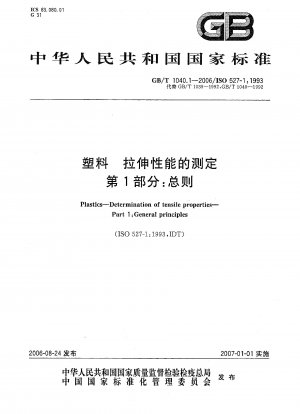GB/T 1040.1-2006
Plastics.Determination of tensile properties.Part 1:General principles (English Version)
- Standard No.
- GB/T 1040.1-2006
- Language
- Chinese, Available in English version
- Release Date
- 2006
- Published By
- General Administration of Quality Supervision, Inspection and Quarantine of the People‘s Republic of China
- Status
- 2019-11
- Replace By
- GB/T 1040.1-2018
- Latest
- GB/T 1040.1-2018
- Replace
- GB/T 1039-1992 GB/T 1040-1992
- Scope
- 1.1 This part of GB/T 1040 specifies the general principles for determining the tensile properties of plastics and composite materials under specified conditions, and specifies several different shapes of test specimens for different types of materials. These materials are specified in other parts of this standard. part is detailed. 1.2 This method is used to study the tensile properties of samples and determine the tensile strength, tensile modulus and other tensile stress/strain relationships under specified conditions. 1.3 This method is applicable to the following materials: — rigid and semi-rigid thermoplastic molding and extrusion materials, including filled and reinforced compounds in addition to unfilled types, rigid and semi-rigid thermoplastic sheets and films ; - rigid and semi-rigid thermosetting molding materials, including filled and reinforced composites, rigid and semi-rigid thermosetting sheet materials, including laminates; - fiber-reinforced thermosetting materials mixed with unidirectional or non-directional reinforcement and thermoplastic composites, such as mats, fabrics, rovings, chopped strands, hybrid fiber reinforcements, rovings and milled fibers, etc.; sheets made of pre-impregnated materials (prepregs); - Thermotropic liquid crystal polymers. This method is generally not applicable to rigid foams or sandwich structures containing microcellular materials. 1.4 Specimens used in this method may be molded to selected dimensions, or may be machined by cutting, punching, etc., from finished or semi-finished moldings, laminates, films, extruded or cast sheets, etc. become. In some cases, multi-purpose test pieces can be used (see IS03167:1993 "Plastics - Preparation and use of multi-purpose test pieces"). 1.5 This method specifies preferred dimensions for specimens. The results of tests performed on specimens of different dimensions or prepared under different conditions are not comparable. Other factors, such as test speed and conditioning of the specimen, can also affect test results. Therefore, when data comparisons are required, these influencing factors must be strictly controlled and documented.
GB/T 1040.1-2006 Referenced Document
- GB/T 17200-1997 Requirements for tensile, flexural and compression testing machines for rubbers and plastics
- GB/T 2918-1998 Plastics--Standard atmospheres for conditioning and testing
- ISO 2602:1980 Statistical interpretation of test results; estimation of the mean; confidence interval
GB/T 1040.1-2006 history
- 2018 GB/T 1040.1-2018 Plastics—Determination of tensile properties—Part 1:General principles
- 2006 GB/T 1040.1-2006 Plastics.Determination of tensile properties.Part 1:General principles
- 1992 GB/T 1040-1992 Plastics-Determination of tensile properties
GB/T 1040.1-2006 Plastics.Determination of tensile properties.Part 1:General principles has been changed from GB/T 1039-1992 Plastics--General rules for the test method of mechanical properties.

GB/T 1040.1-2006 -All Parts
GB/T 1040.1-2018 Plastics—Determination of tensile properties—Part 1:General principles
GB/T 1040.2-2022 Plastics—Determination of tensile properties—Part 2: Test conditions for moulding and extrusion plastics
GB/T 1040.3-2006 Plastics. Determination of tensile properties. Part 3: Test conditions for films and sheets
GB/T 1040.4-2006 Plastics. Determination of tensile properties. Part 4: Test conditions for isotropic and orthotropic fibre-reinforced plastic composites
GB/T 1040.5-2008 Plastic.Determination of tensile properties.Part 5:Test conditions for unidirectional fibre-reinforced plastic composites